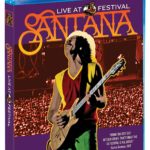Using the unscientific, fluctuating, and subjective metric known as the cool factor, the US Festival of 1982 has been re-evaluated in recent years, scoring as highly now, if not higher, as it did when it first occurred. The Labor Day weekend convergence of rock and pop, conceived by Apple co-founder Steve Wozniak and iconic music promoter Bill Graham, drew hundreds of thousands to the desert-dry hills of San Bernardino, California, notably featuring The Police, Grateful Dead, Tom Petty and the Heartbreakers, and Santana, among others. Looking back, it sounds like a dream lineup, and for many it was, but context means something: this was 1982.
Arguably The Police were near their populous-appealing peak; Petty, a primed headliner; the Dead always had their faithful. Santana was at a plateau (slotted on this Saturday afternoon between Eddie Money and The Cars); the performance is a balance between supporting the then-just released Shango and the classics from the early days. The musicianship remains of the highest quality, with Carlos playing as fiery as ever. Drummer Graham Lear, lionized in band history for his “Soul Sacrifice” drum solo from Moonflower, is back in the ensemble, pushing Carlos and company through breathless takes of “Black Magic Woman/Gypsy Queen,” and “Oye Como Va.” The contemporaneous entries, however, such as “Searchin’,” “Nowhere to Run” and “Hold On” are largely anonymous next to the more familiar “Jingo Lo Ba” (with its percussive conflagration) and “Incident at Neshabur,” the latter featuring a jazz-soaked appearance on keyboard by guest Herbie Hancock.
Why this tidy 90-minute DVD works as neatly as it does are the contemporary interviews with Carlos Santana interspersed with his band’s appearance three-and-a-half decades earlier, raising this above a simple archival release. He responds to broad subjects like festival ethos, and his origins and playing style, but zeroes in on specifics. With hindsight as his friend, including when stating Wozniak’s imaginative goal succeeded as a concept, (despite most reports that it was a financial disaster), he convincingly aligns the US Festival with the resoundingly positive spirit of Woodstock (also a financial disaster).
In reframing the legacy of the US fest- an event that just by lineup alone can claim legendary status- and pairing it with the group’s hour-plus set onstage that was as well-executed and inspired as any before or since, Santana gives plenty of new reasons to revisit this often-overlooked festival.



No Comments comments associated with this post